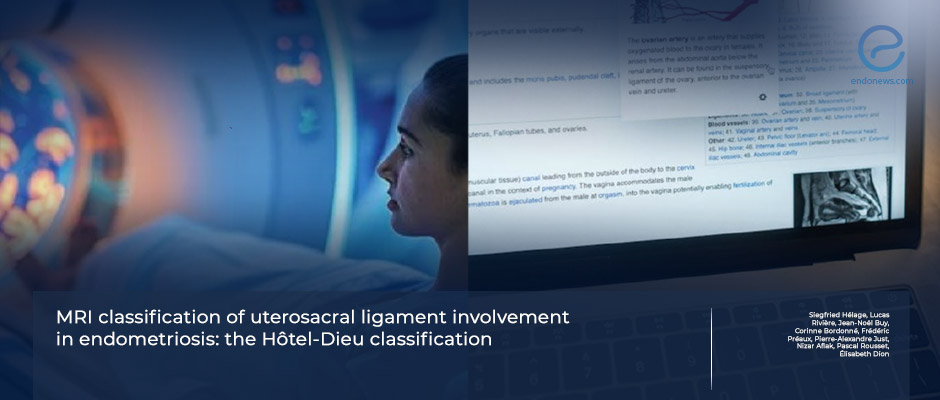Non-invasive MRI Based Detection of Uterosacral Deep Infiltrating Endometriosis
Jan 2, 2025
MRI Based Detection of Uterosacral Ligament Deep Infiltrating Endometriosis May Facilitate Tailored Management
Key Points
Importance:
- MRI staging of uterosacral ligament involvement in endometriosis may be used as a non-invasive staging of the disease, when possible.
Highlights:
- As a non-invasive tool, MRI provides a safe and accessible option for preooperative evaluation of uterosacral ligament involvement and the system may help standardize the reporting and make it easier to communicate about the findings.
- On the other hand, a normal MRI cannot be used to rule out a DIE diagnosis.
What's done here:
- A French radiologist team retrospectively evaluated the MRI of 22 women who underwent lapaaroscopy and histopathologic evaluation for clinical suspicion of deep infiltrating endometriosis.
- The study aimed to build a preoperative MRI classification by classifying the uterosacral ligament features depending on their positive predictive values based on histologic confirmations.
Key Results:
- Authors developed an MRI Classification System based on T2-weighted images, divided into two categories:
- L-category (Linear types : 1, 2, 3A, and 3B) wwith Regular or irregular margins, and positive predictive values for the presence of endometriosis range from 75% to 88%.
- N-category (Hemorrhagic or nodular types : 4, 5A, 5B, and 6), with positive predictive value of 100%; hence, high diagnostic confidence.
- This system helps standardize MRI reports and enhances communication between clinicians and patients.
- A normal MRI cannot rule out a DIE diagnosis.
Lay Summary
Hélage et al., from the Department of Radiology at Hôtel-Dieu de Paris, aimed to create a preoperative MRI classification for USL endometriosis based on histopathological correlations. Three independent radiologists retrospectively analyzed the MRIs of 22 women, blinded to histopathologic diagnoses, to evaluate the accuracy of their findings.
The authors developed a two-category MRI classification system based on T2-weighted images. The "L-category" includes linear types (1, 2, 3A, and 3B) with regular or irregular margins, showing positive predictive values ranging from 75% to 88%. The "N-category" includes hemorrhagic or nodular types (4, 5A, 5B, and 6). This system uses a 1-6 scale to assess the likelihood of DIE, standardizing MRI reports and facilitating clearer communication between clinicians and patients. On the other hand, it is important to note that a normal MRI cannot be used to rule out a DIE diagnosis.
In this article that appeared in a recent issue of the British Journal of Radiology, the authors suggest that their MRI classification system provides an effective, non-invasive method for staging USL involvement in symptomatic women. This approach enables rapid diagnosis and more tailored, confident management of endometriosis.
Research Source: https://pubmed.ncbi.nlm.nih.gov/38579251/
uterosacral ligament deep infiltrated endometriosis magnetic resonance imaging classification radiologic type Hotel-Dieu endometriosis.

